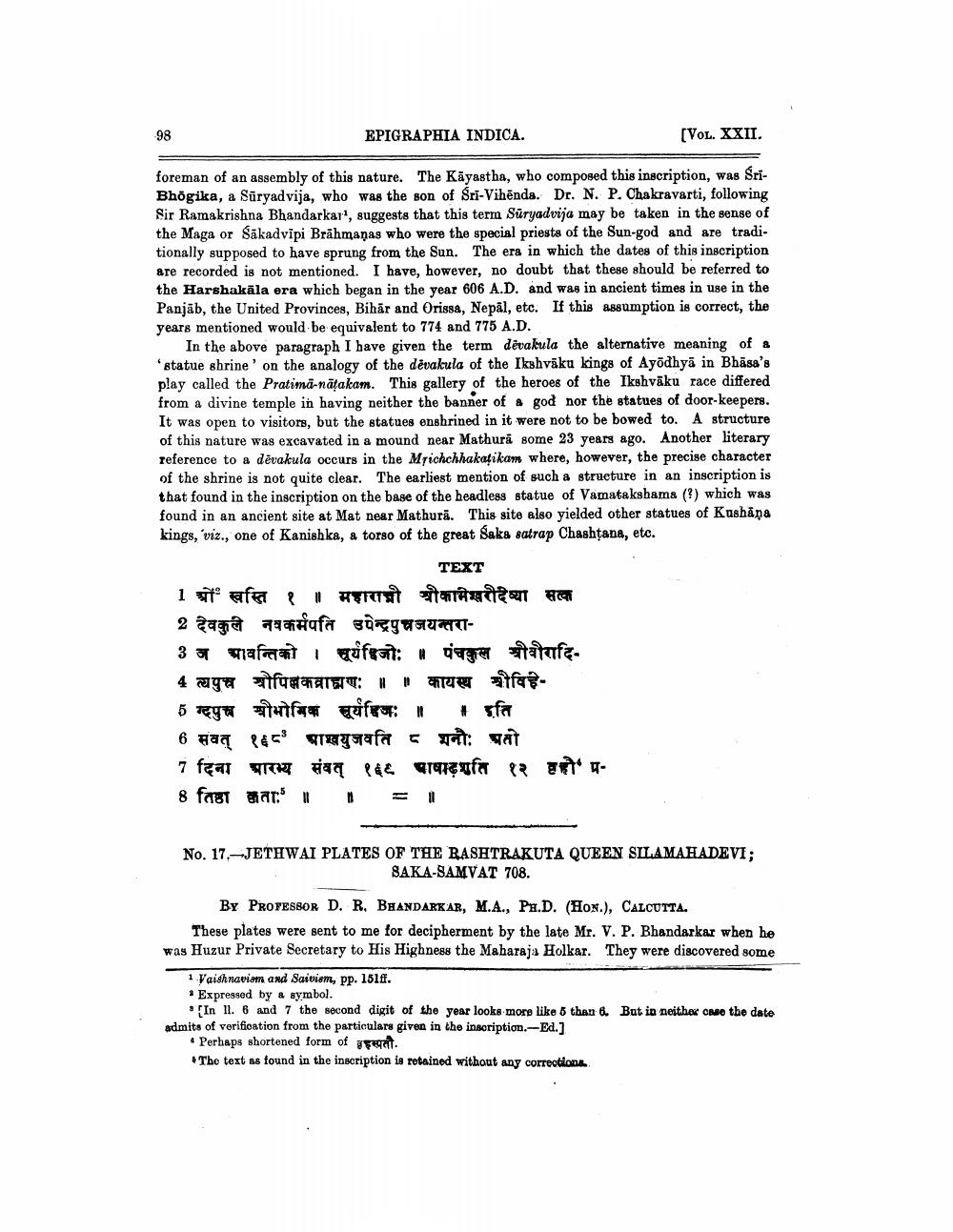________________
98
EPIGRAPHIA INDICA.
[VOL. XXII.
foreman of an assembly of this nature. The Kayastha, who composed this inscription, was ŚriBhōgika, a Süryadvija, who was the son of Sri-Vihenda. Dr. N. P. Chakravarti, following Sir Ramakrishna Bhandarkar1, suggests that this term Süryadvija may be taken in the sense of the Maga or Sakadvipi Brāhmaṇas who were the special priests of the Sun-god and are traditionally supposed to have sprung from the Sun. The era in which the dates of this inscription are recorded is not mentioned. I have, however, no doubt that these should be referred to the Harshakala era which began in the year 606 A.D. and was in ancient times in use in the Panjab, the United Provinces, Bihar and Orissa, Nepal, etc. If this assumption is correct, the years mentioned would be equivalent to 774 and 775 A.D.
In the above paragraph I have given the term devakula the alternative meaning of a 'statue shrine' on the analogy of the devakula of the Ikshvāku kings of Ayodhya in Bhasa's play called the Pratima-naṭakam. This gallery of the heroes of the Ikshvāku race differed from a divine temple in having neither the banner of a god nor the statues of door-keepers. It was open to visitors, but the statues enshrined in it were not to be bowed to. A structure of this nature was excavated in a mound near Mathura some 23 years ago. Another literary reference to a devakula occurs in the Mrichchhakatikam where, however, the precise character of the shrine is not quite clear. The earliest mention of such a structure in an inscription is that found in the inscription on the base of the headless statue of Vamatakshama (?) which was found in an ancient site at Mat near Mathura. This site also yielded other statues of Kushāņa kings, viz., one of Kanishka, a torso of the great Saka satrap Chashtana, etc.
TEXT
1 tafa? | महारानी श्रीकामेश्वरीदेव्या सत्क
2 देवकुले नवकर्मपति उपेन्द्रपुत्रजयन्तरा
3 ज अवन्तिको । सूर्यदिजः ॥ पंचकुल श्रीवीरादि4 त्यga श्रपिलकब्राह्मणः ॥ ॥ कायस्थ श्रीविहे5 reg utfum fer: + sfa 6 संवत् १६८० चाश्वयुजवति ८ शनौः अतो
दिना भारभ्य संवत् १५८ चावटपति १२ हो प
8 fast aar || | = |
No. 17. JETHWAI PLATES OF THE RASHTRAKUTA QUEEN SILAMAHADEVI; SAKA-SAMVAT 708.
BY PROFESSOR D. R. BHANDARKAR, M.A., PH.D. (HON.), CALCUTTA.
These plates were sent to me for decipherment by the late Mr. V. P. Bhandarkar when he was Huzur Private Secretary to His Highness the Maharaja Holkar. They were discovered some
1 Vaishnavism and Saivism, pp. 151ff. Expressed by a symbol.
[In 11. 6 and 7 the second digit of the year looks more like 5 than 6. But in neither case the date admits of verification from the particulars given in the inscription.-Ed.]
4 Perhaps shortened form of बृहस्पती.
The text as found in the inscription is retained without any corrections..




